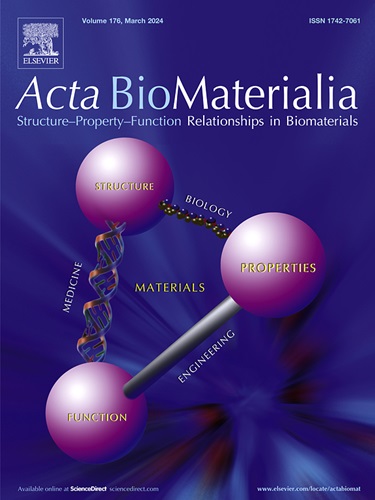具有血清耐药和佐剂作用的氟化聚乙烯亚胺载体递送lmp2mrna疫苗用于鼻咽癌治疗
IF 9.4
1区 医学
Q1 ENGINEERING, BIOMEDICAL
引用次数: 0
摘要
潜伏膜蛋白2 (Latent membrane protein 2, LMP2)是eb病毒(EBV)潜伏期介导转移和复发的重要蛋白,作为鼻咽癌mRNA疫苗的靶向抗原具有很大的潜力。本研究以血清耐药氟化聚乙烯亚胺(TKPF)为基础,研制了一种具有自辅助作用的LMP2 mRNA疫苗,在鼻咽癌治疗中获得了较强的抗肿瘤免疫。具体来说,拟议的疫苗PEG[TKPF/mLMP2]由阳离子TKPF和LMP2 mRNA形成的TKPF/mLMP2核心以及双醛聚乙二醇(OHC-PEG-CHO)涂层组成。PEG[TKPF/mLMP2]表现出较少的蛋白质吸收,使血清抵抗在50% FBS培养基下保持50%的转染效率。此外,体外研究表明,PEG[TKPF/mLMP2]可以通过正电荷和氟基团增强DC细胞对mRNA的内化和溶酶体逃逸,随后高效转染和表达,最终触发DC成熟和抗原向T细胞递呈。激活后的抗原特异性T细胞会攻击表达LMP2的肿瘤细胞,并释放促炎细胞因子,包括IFN-γ、IL-6和TNF-α。此外,体内研究表明,在预防和治疗模型中,用PEG[TKPF/mLMP2]转染脾脏和激活T细胞都能有效地阻止肿瘤细胞的生长,延长小鼠的生存期。值得注意的是,PEG[TKPF]显示出自辅助作用,诱导强烈的免疫反应,提高LMP2 mRNA的抗肿瘤能力。综上所述,高效自佐剂载体促进制备的lmp2mrna疫苗具有较强的免疫治疗效果,为鼻咽癌治疗提供了可能的解决方案。意义声明:潜伏膜蛋白2 (Latent membrane protein 2, LMP2)是eb病毒(EBV)转移和复发的关键蛋白,可作为mRNA疫苗开发的抗原靶向治疗鼻咽癌(NPC)。然而,目前的LMP2疫苗在诱导强效抗鼻咽癌免疫方面仍然效率低下。虽然mRNA已成为恢复LMP2疫苗开发的有效工具,但它仍然受到血清条件和弱免疫反应的影响。在本研究中,我们开发了一种基于血清耐药氟化聚乙烯亚胺(TKPF)的LMP2 mRNA疫苗,具有自辅助作用,可在鼻咽癌治疗中获得较强的抗肿瘤免疫。提出的PEG[TKPF/mLMP2]疫苗在预防和治疗小鼠模型中有效地递送到树突状细胞(dc)以激活T细胞成熟,最终抑制表达lmp2的肿瘤的生长。本文章由计算机程序翻译,如有差异,请以英文原文为准。

Fluorinated polyethyleneimine vectors with serum resistance and adjuvant effect to deliver LMP2 mRNA vaccine for nasopharyngeal carcinoma therapy
Latent membrane protein 2 (LMP2), which is an important protein of Epstein-Barr virus (EBV) in the latent phase to mediate metastasis and recurrence, has shown great potential as a targeting antigen in mRNA vaccine for nasopharyngeal carcinoma (NPC) therapy. In this study, an LMP2 mRNA vaccine was developed based on a serum-resistant fluorinated polyethyleneimine (TKPF) with the self-adjuvant effect for achieving a strong anti-tumor immunity in NPC treatment. Specifically, the proposed vaccine PEG[TKPF/mLMP2] was comprised of a TKPF/mLMP2 core formed by the cationic TKPF and LMP2 mRNA, together with a dialdehyde poly (ethyl glycol) (OHC-PEG-CHO) coating. PEG[TKPF/mLMP2] showed less protein absorption to enable serum resistance to maintain ∼50 % transfection efficiency under 50 % FBS media. In addition, PEG[TKPF/mLMP2] could render enhanced internalization and lysosomal escape of mRNA by DC cells via positive charge and fluorine groups, followed by efficient transfection and expression, eventually triggering DC maturation and antigen presentation to T cells as demonstrated by in vitro studies. The activated antigen-specific T cells would attack tumor cells expressing LMP2 and release pro-inflammatory cytokines including IFN-γ, IL-6, and TNF-α. Furthermore, in vivo studies manifested effective spleen transfection and activated T cells by PEG[TKPF/mLMP2] to prevent tumor cell growth and prolong mouse survival in both prophylactical and therapeutical models. Notably, PEG[TKPF] revealed self-adjuvant effect to induce a strong immune response for boosting the anti-tumor potency of LMP2 mRNA. In summary, the fabricated LMP2 mRNA vaccine facilitated by the efficient and self-adjuvant vector induced robust immunotherapeutic efficacy, providing a possible solution for NPC therapy.
Statement of Significance
Latent membrane protein 2 (LMP2), which is a key Epstein-Barr virus (EBV) protein for metastasis and recurrence, can be targeted as an antigen for mRNA vaccine development to treat nasopharyngeal carcinoma (NPC). However, the current LMP2 vaccine is still inefficient in inducing potent anti-NPC immunity. Although mRNA has emerged as an effective tool to rejuvenate LMP2 vaccine development, it still suffers from vulnerability to serum conditions and weak immune response. In this study, we developed an LMP2 mRNA vaccine based on a serum-resistant fluorinated polyethyleneimine (TKPF) with self-adjuvant effects to achieve strong anti-tumor immunity in NPC treatment. The proposed PEG[TKPF/mLMP2] vaccine efficiently delivers to dendritic cells (DCs) for activating T cell maturation, ultimately suppressing the growth of LMP2-expressing tumors in both prophylactic and therapeutic mouse models.
求助全文
通过发布文献求助,成功后即可免费获取论文全文。
去求助
来源期刊

Acta Biomaterialia
工程技术-材料科学:生物材料
CiteScore
16.80
自引率
3.10%
发文量
776
审稿时长
30 days
期刊介绍:
Acta Biomaterialia is a monthly peer-reviewed scientific journal published by Elsevier. The journal was established in January 2005. The editor-in-chief is W.R. Wagner (University of Pittsburgh). The journal covers research in biomaterials science, including the interrelationship of biomaterial structure and function from macroscale to nanoscale. Topical coverage includes biomedical and biocompatible materials.
 求助内容:
求助内容: 应助结果提醒方式:
应助结果提醒方式:


